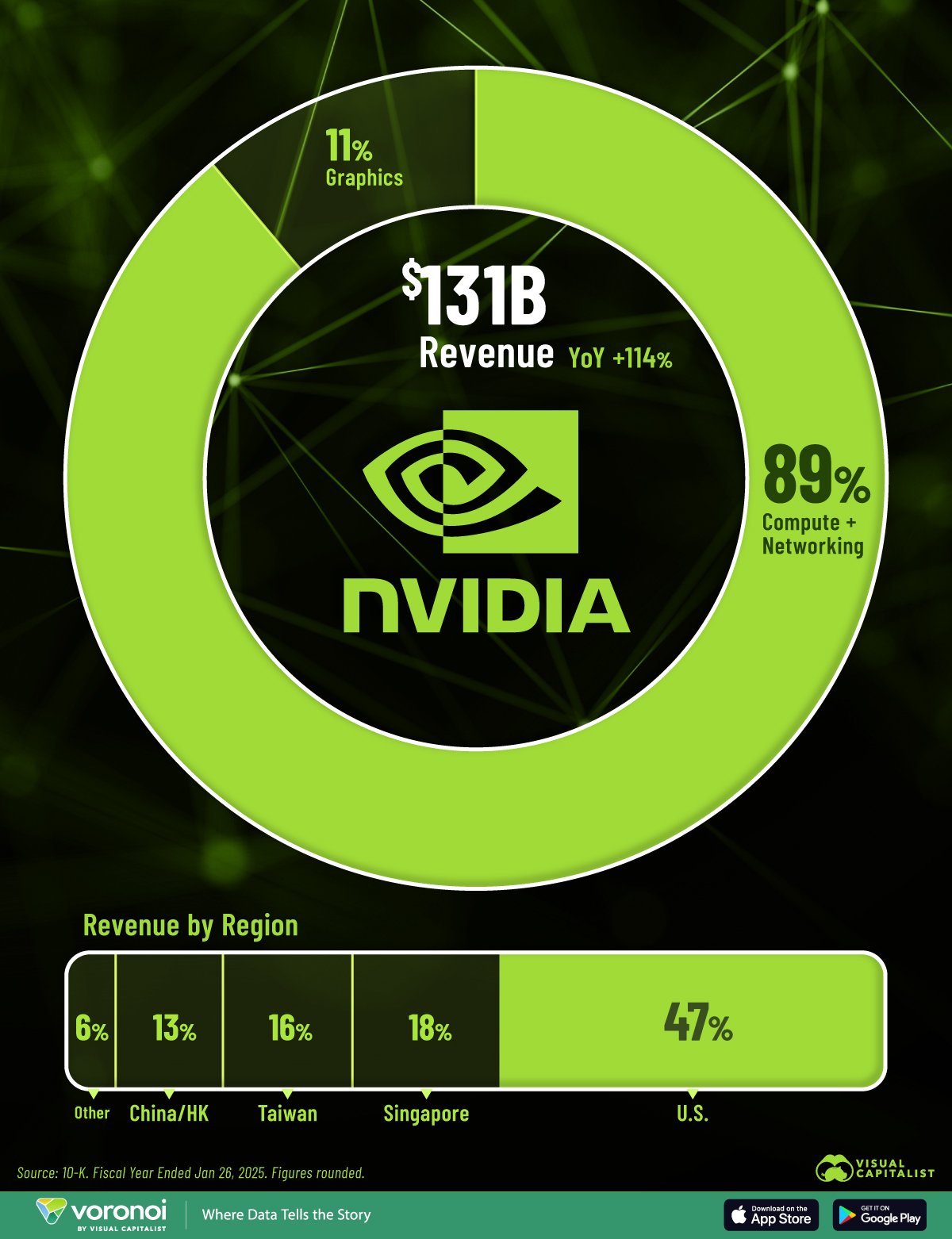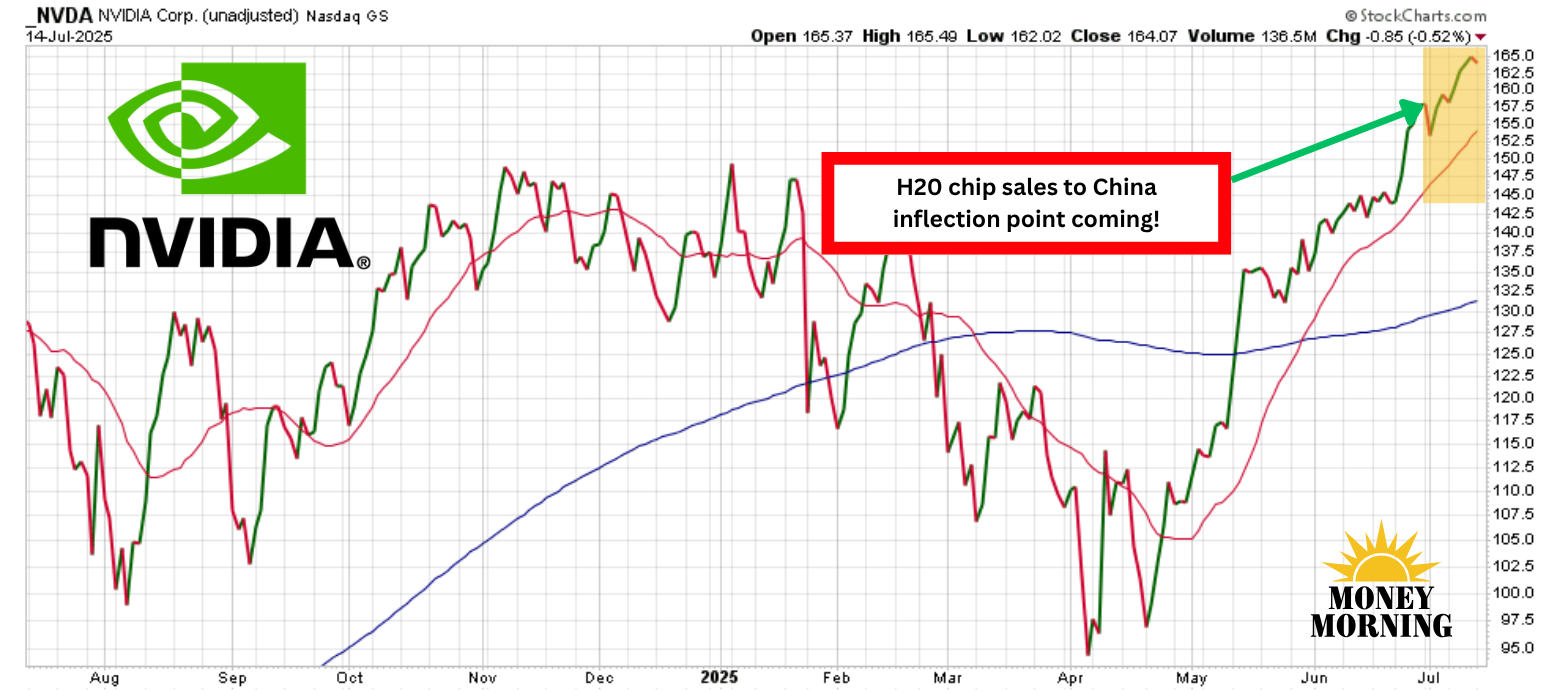In a pivotal moment for the global technology landscape, Nvidia (NVDA) said it received approval from the U.S. government to resume sales of its H20 artificial intelligence (AI) chips to China,a dramatic reversal of the Trump administration’s previously imposed export restrictions.
Announced late last night, this decision sent NVDA stock racing almost 6% higher in after-hours trading and could unlock billions in revenue for the world’s most valuable chipmaker.
The move not only signals a potential thaw in U.S.-China trade tensions but also positions Nvidia to reclaim a substantial share of the Chinese market, a critical region for its growth ambitions.
The H20 Chip: The Key to China’s AI Market
The H20 graphics processing unit (GPU) chip, specifically designed to comply with U.S. export controls, was Nvidia’s most powerful AI chip legally available in China. Introduced after restrictions in 2022 and tightened in 2023, the H20 is a downgraded version of Nvidia’s H100 chip, tailored to meet national security thresholds while supporting AI inference tasks critical for companies like Tencent (TCEHY), Alibaba (BABA), and ByteDance.
These firms have scrambled to secure H20 chips, with orders reportedly reaching $18 billion since January, reflecting China’s booming demand for cost-effective AI solutions. The White House’s approval to resume sales, reversing a ban in April, allows Nvidia to again tap into this massive market.
Chinese tech giants are already submitting applications through Nvidia’s whitelist process, ensuring rapid order fulfillment once licenses are granted.
A $5 Trillion Valuation in Sight?
The NVDA stock surge following the announcement reflects investor optimism about re-entering China, a market Nvidia’s CEO described as “massive, dynamic, and highly innovative.” The H20 ban had cost Nvidia $15 billion in lost sales and a $5.5 billion inventory write-off, but resuming shipments could recover significant revenue.
Analysts estimate Nvidia could ship 1 million to 1.2 million H20 GPUs in 2025, potentially adding billions to its top line. Combined with Nvidia’s new RTX Pro GPU, designed for digital twin AI applications in smart factories, this move strengthens its dominance in China’s AI sector, where competitors like Huawei lag behind Nvidia’s CUDA platform.
Analysts predict that this dual strategy – resuming H20 sales and introducing the RTX PRO – could help Nvidia recover $4.5 billion to $5.5 billion in lost revenue, with potential for a multi-billion-dollar boost in 2025 alone
If Nvidia sustains its 13% revenue share from China and grows its global AI chip leadership, a $5 trillion valuation – a 25% increase to its current market cap – becomes plausible within the next year or so, if not sooner.
 High-Stakes Diplomacy Pays Off
High-Stakes Diplomacy Pays Off
The approval to resume H20 sales follows intense diplomatic efforts by Nvidia CEO Jensen Huang who engaged with U.S. policymakers, including President Trump, and Chinese counterparts.
Huang’s meetings emphasized Nvidia’s commitment to U.S. job creation and AI leadership while addressing national security concerns. Nvidia’s statement about the development confirmed that the company is filing applications to restart H20 exports, with licenses expected to be granted soon.
This greenlight has sparked a frenzy among Chinese firms eager to secure H20 chips for AI-driven applications like smart factories and logistics.
The broader AI semiconductor supply chain also responded, with Advanced Micro Devices (AMD) gaining 4% in pre-market trading. The Nasdaq-100, which had already closed at a new all-time high yesterday before the announcement, was up premarket, as were the S&P 500 and Dow Jones Industrial Average.
 A Transformative Moment for Nvidia’s Future
A Transformative Moment for Nvidia’s Future
This shift is a golden opportunity for NVDA to capitalize on China’s immense demand for AI infrastructure, where tech giants are racing to develop advanced AI models for applications like autonomous vehicles and cloud computing.
For Nvidia, the reinstatement of H20 sales is more than a financial windfall; it’s a reaffirmation of its central role in the global AI race. The company’s ability to recover lost ground in China could solidify its race toward a $5 trillion market valuation and beyond, positioning it as the cornerstone of the AI-driven future.
The Bottom Line
Nvidia’s U.S. approval to resume H20 chip sales to China unlocks billions in potential revenue, boosting its stock and AI market dominance. The new RTX PRO GPU complements this strategy, while easing U.S.-China tensions signal growth opportunities, despite national security concerns, positioning Nvidia for a transformative future.
The path forward isn’t completely smooth, as several U.S. senators called on Nvidia to limit which companies and industries it meets with on future sales. It is clear, however, the reopening of the China market to Nvidia for advanced AI chip sales is a major catalyst for growth and represents what could be a new inflection point for NVDA stock.
— Rich Duprey
Out of 23,281 Stocks... Only ONE is This Profitable and Undervalued. [sponsor]$3 billion+ in operating income. Market cap under $8 billion. 15% revenue growth. 20% dividend growth. No other American stock but ONE can meet these criteria... here's why Donald Trump publicly backed it on Truth Social. See His Breakdown of the Seven Stocks You Should Own Here.
Source: Money Morning
